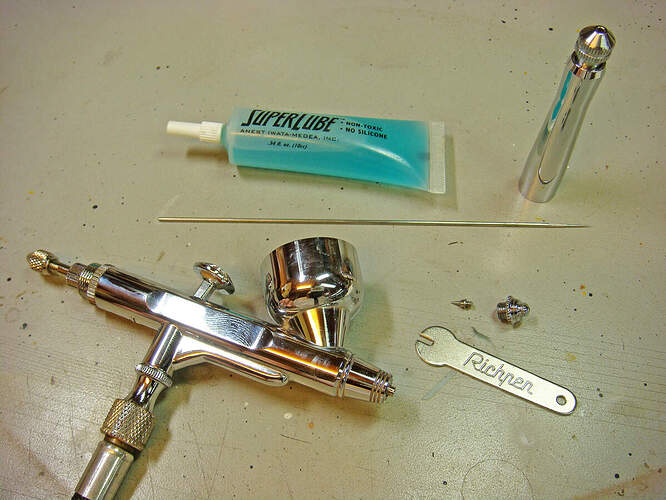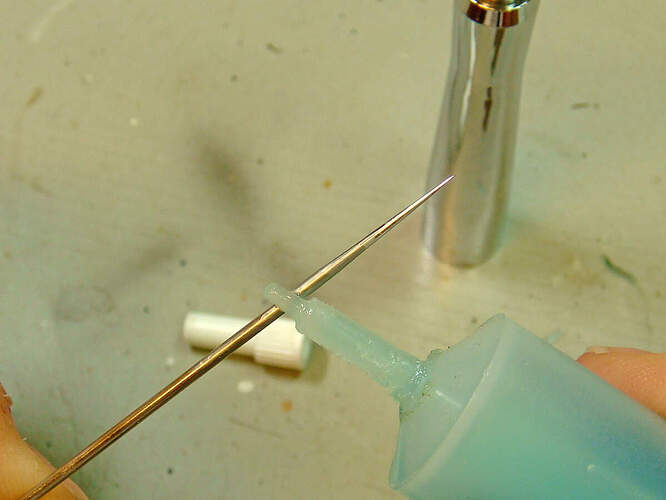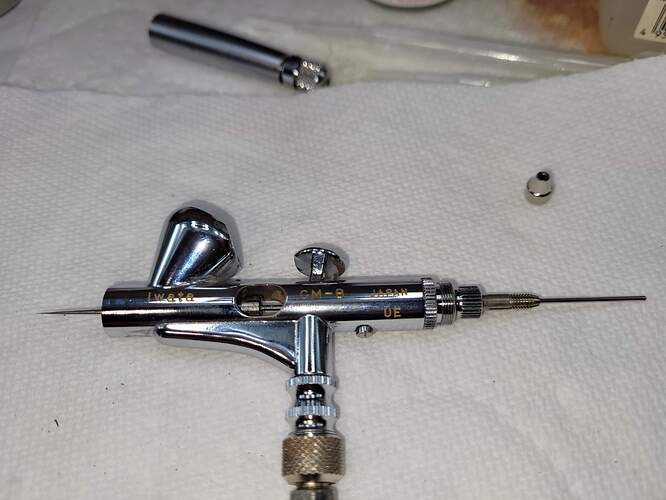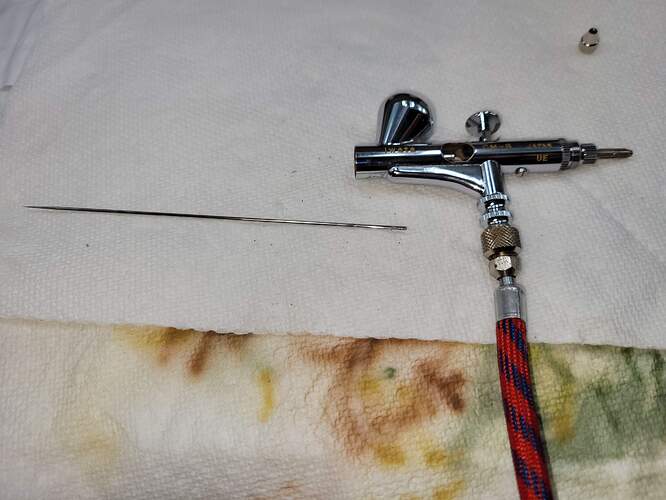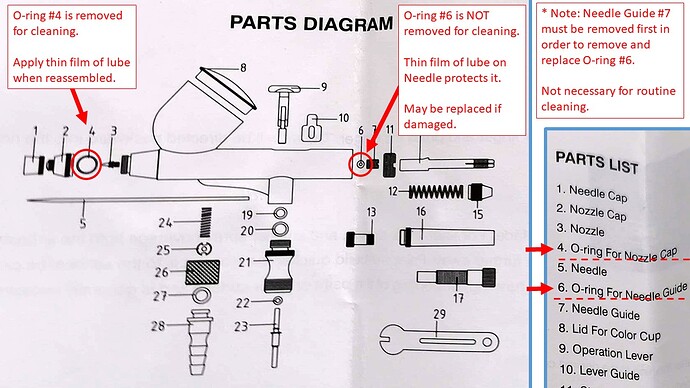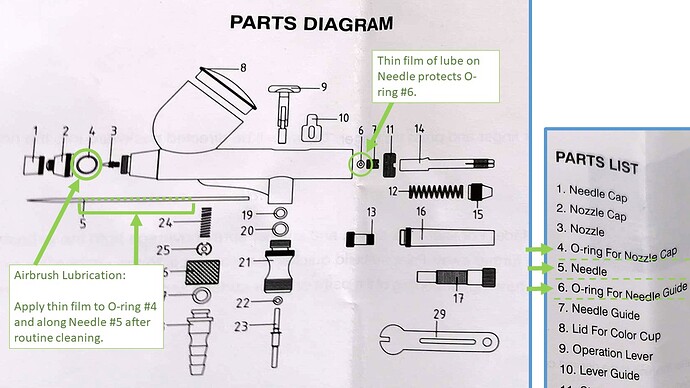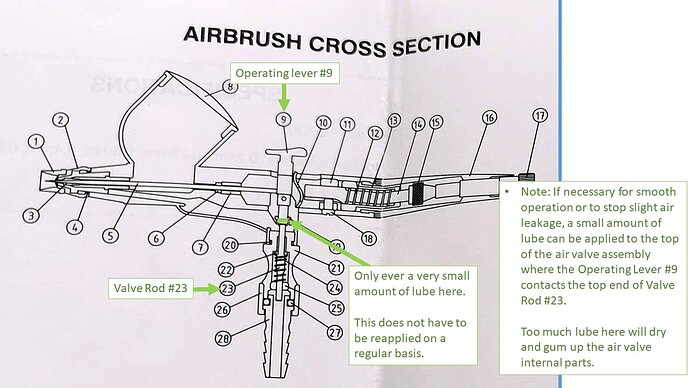So, you must of course decide for yourself about taking your airbrush apart for cleaning. I can only repeat that in my experience the majority of problems modelers have with their airbrushes are the result of poor cleaning practices.
The damage to the end of your “needle cap” (part #1 on your diagram, I think) is not serious. You can file and sand the burs smooth if you like. It may be possible that if any of the burs or dents go towards the inside of the cap that they may disrupt the pattern of spray or collect droplets of paint (causing spatters). As Mead93 says, you can remove this to spray. (I don’t use the one on my airbrush at all except when storing it to protect the needle.)
This YouTube video might help with assembly. I believe that it shows an airbrush very similar to yours (the needle adjusting / limiting device is a bit different, but the rest appears pretty much the same):
Airbrush Basics:: Master G33 Assembly
I’m tempted to say watch this with the sound turned off because the presenter offers some, IMO, bad advice, but in the main what she says is good info… So here are the points that I disagree with:
I totally disagree with her advice on using ANY type of oil in your airbrush except one of the proprietary airbrush lubes or common drugstore glycerin. DO NOT USE “sewing machine” oil or any other such lubricant. Mineral oils will give you problems with your paints. They will contaminate the paint and cause issues with uneven drying (enamels and lacquers) or “fish eyes” (water-based acrylics).
DO NOT USE so much lubricant as she does. Her problems with her air valve are quite possibly because she has used too much lubricant in the past and her valve assembly is now gummed up with dried airbrush lube. A very light film is all any of the o-rings need, and just a very small amount spread on the needle from the shoulder of the tip back an inch or so.
(You should never have to clean your air valve assembly unless you allow paint to get into the handle and trigger areas of the airbrush body. If you do have to clean it, please don’t flood it with lubricant afterward. That excess lube will simply get into the airstream and possibly cause problems with your paint. The excess will also eventually dry into a waxy buildup causing the exact same kind of problem the presenter is having.)
Find a cleaning solvent that will dissolve the kinds of paint that you spray once it has dried. The presenter uses rubbing alcohol (~70% isopropyl alcohol). If this works for her, good. I think you will find that with most model paints you will need something stronger. I spray Tamiya and Floquil paints. These are both thinned (reduced) with lacquer thinners (aka “cellulose thinners”) and this is also what I use to clean my airbrush.
Lacquer thinners will also generally remove all other types of hobby paints, even once dried. Lacquer thinners WILL NOT HARM any of the parts of your airbrush, to include the o-rings and other seals. Consider that these same airbrushes are used by commercial and industrial painters to spray automotive lacquer and 2K paints. If the thinners for these destroyed the equipment, airbrush makers would use better materials.
Ammonia based cleaners will not cause any long term problems. Many air brushers use glass cleaner to clean their airbrushes. There is nothing wrong with this if it gets the paint out. The ammonia might cause some discoloration in any exposed brass on some metal parts, but the amount of ammonia contained in household glass cleaner or even straight ammonia will not harm your airbrush. These cleaners evaporate from the airbrush and are not allowed to linger on its surface for days, months or years. This myth about ammonia damaging airbrushes comes from a false association of “brass rot” with airbrushes. (The history of the effect is too long to go into here. Suffice it say that the circumstances that cause “brass rot” are very different than the simple use of household ammonia products to clean airbrushes.)
You can try alcohol, like the presenter, but I think you will find that it will not dissolve dried on paint.
The presenter’s description of the difference between a single action airbrush and a double (or dual) action airbrush is a bit backwards, but that doesn’t change the useful airbrush assembly content. The rest of her presentation (hoses, regulators, compressors, etc.) is alright.
BTW, to avoid getting your airbrush hose in the way when you’re painting, simply wrap the hose once around the wrist of the hand holding the airbrush.
Finally, don’t be afraid to use the small wrench that came with your airbrush to remove and reinstall the paint tip. Just don’t over tighten it.
